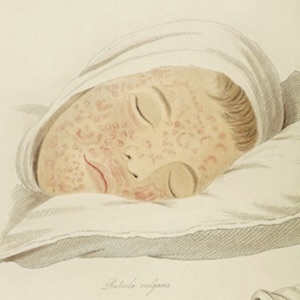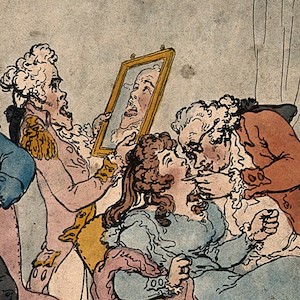Early Modern (1450 CE - 1800 CE)

Aztec Cradleboard Figurine and Drawing
The ceramic figurine of an infant in a cradle (also called a cradleboard) was created by the Nahua, or Aztec people of Mexico, between 1350 and 1521 CE.

Rubeola Vulgaris - Measles
Robert Willan (1757-1812) was a physician who practiced in London. Like Sydenham he was fascinated by the relation of weather to epidemics and kept strict records on when they occurred over several years.

Transplanting Teeth
This print is by Thomas Rowlandson (1756-1827) and is dated 1787. It is a satirical comment upon the real practice of rich gentlemen and ladies of the 18th century paying for teeth to be pulled from poor children and transplanted in their gums. The dentist present is portrayed as a quack.

Emile
French philosopher Jean-Jacques Rousseau wrote the philosophical treatise Emile, or On Education in 1762. In it, he imagines a situation in which a young tutor devotes 20 years to raising a single child.

The Days of 31 May and 1-2 June 1793
Even though popular action had unseated the Legislative Assembly and replaced it with the Convention, the elections that followed had not satisfied the radicals of Paris and their artisanal followers.

Native American Children and Toys
Theodore de Bry included this colorful engraving in his publication of Hariot's, A Briefe and True Report of the New Found Land of Virginia (1590). It was based on a watercolor by John White (fig. 2) painted five or six years earlier.

Terakoya vs. Meiji School
Contrary to impression left by document #2, schools for commoners were plentiful prior to the Meiji Restoration in 1868.

Ayyubid and Ottoman Architecture
In the Islamic world, women were able to own and control their own property at a time when Christian women in Europe were unable to do so. Many wealthy women endowed public buildings as a mark of their piety.

Massacre of the Prisoners
Yet another image from the newspaper R*volutions de Paris shows crowds massacring refractory clergy and prisoners.

Massacre of the Priests
This image, also reproduced from the newspaper R*volutions de Paris, shows crowds massacring refractory clergy and prisoners.